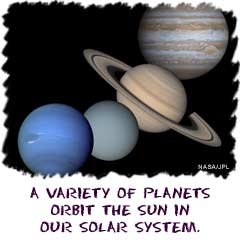|
|
||||||||||||||||||||||||||||||
 |
|

|
||||||||||||||||||||||||||||
A Solar System From Dust Our system of one star and eight planets was born about 4.6 billion years ago. All of the pieces were created at the same time. But wait! It wasn't a big "POOF!" and everything was here. It took billions of years for the entire system to develop. All of the gases, dust, and pieces of the system were around at the start. Eventually a star, eight planets, some smaller dwarf planets (like Pluto), and an asteroid belt developed. There wasn't even a star when the Solar System started out.
Our system of one star and eight planets was born about 4.6 billion years ago. All of the pieces were created at the same time. But wait! It wasn't a big "POOF!" and everything was here. It took billions of years for the entire system to develop. All of the gases, dust, and pieces of the system were around at the start. Eventually a star, eight planets, some smaller dwarf planets (like Pluto), and an asteroid belt developed. There wasn't even a star when the Solar System started out.
Start With A StarThe system began as a spinning blob of gases. As the blob spun for millions and millions of years, it began to flatten. It probably looked like that shape for a flying saucer. It was a round, flattened disk with a bulge in the middle. That bulge was the beginning of the Sun. Scientists call that "baby" sun a protosun. The last step for the Sun was the magic that ignited it and caused it to shine. Do you remember that dust and gas swirling around that didn't become the Sun? The disk flattened even more and the planets began to develop.Planets From The PiecesEight planets developed and now orbit the Sun. As you move away from the Sun, you will first find four planets, then a group of small asteroids, and four large Jovian planets. There are also objects called dwarf planets that include bodies such as Pluto and Charon. In the past few years, astronomers have started to discover smaller objects beyond Pluto in the Kuiper Belt. The distance from the Sun to the Earth is considered "1" (scientists call that distance an astronomical unit).The average distance to Pluto from the Sun is 39.5. The Voyager probes launched decades ago are just now reaching the outer edges of our Solar System. That edge, called the heliopause, is far beyond the orbit of Pluto.Solids and GasesAs the planets developed, two types began to emerge. In our system, we have planets that are mainly made of rock and those that are mainly made of gases. The official names are terrestrial (rocklike) and Jovian (those with gases). Of the eight planets in our system, Mercury, Venus, Earth, and Mars are the terrestrial planets. The Jovian planets include Jupiter, Saturn, Uranus, and Neptune. The Jovian planets are all much larger and have a lower density when compared to terrestrial planets. Astronomers have recently decided that there are objects in the Universe that are larger that asteroids and comets, but smaller than real planets. These dwarf planets also orbit the Sun and include Pluto, Charon, and others discovered in the Kuiper Belt. You may also hear the term trans-Neptunian objects used to describe those distant dwarf planets. |

|
|||||||||||||||||||||||||||||
Useful Reference MaterialsEncyclopedia.com:http://www.encyclopedia.com/topic/solar_system.aspx Wikipedia: http://en.wikipedia.org/wiki/Solar_system Encyclopædia Britannica: http://www.britannica.com/EBchecked/topic/553008/solar-system | ||||||||||||||||||||||||||||||
|
RETURN TO TOP or Search for more information... * The custom search only looks at Rader's sites. |
|||||||||||||||||||||||||||||
©copyright 1997-2015 Andrew Rader Studios, All rights reserved. Current Page: Cosmos4Kids.com | Solar System | Introduction |
||||||||||||||||||||||||||||||
|
|
||||||||||||||||||||||||||||||

